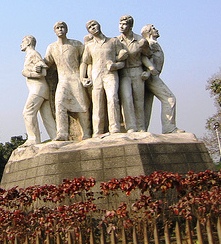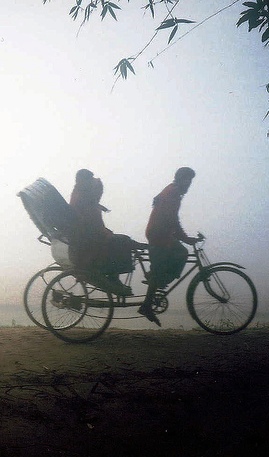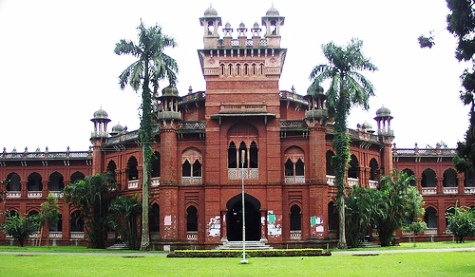How poor are they who have not patience! What wound did ever heal but by degrees.
-William Shakespeare
I grew up in the post-East Pakistan era, and my only exposure to Bangladesh was initially through textbooks that were at best sheepish about the events surrounding its liberation. History was suspended by the school narratives. As a young adult, I was exposed to the injustices once meted out to Pakistan’s largest wing by an outspoken history teacher. Later, when I blurted out those acquired facts in characteristic drawing room discussions, I sensed an unease; silence was advised by a discerning elder.
…The title photo above is of Curzon Hall at Dhaka University…
Such silence, unfortunately, haunted the post-1971 social and cultural milieu of Pakistan. Later in life when I met real Bangladeshis, as opposed to the fictional characters that existed in my mental landscape, I felt a strange affinity despite the fact that we came from contested histories and realities. At college in London I remember long discussions with Bangladeshi friends where we disagreed yet agreed that we had a common future.
Therefore, the recent visit to Dhaka, the very first non fleeting sojourn, was an overpowering experience. Dhaka airport is just another airport. Like home, there are long queues broken by the protocol brigades and immigration officers struggling with the advent of technology. In Dhaka, the warmth of the people overwhelms you.
While there I could not help but think of Faiz‘s only poem written in 1974, hum ke thehre ajnabi, about how close relations become estranged.
After those many encounters, that easy
intimacy, we are strangers now –
After how many meetings will we be that close again?When will we again see a spring of unstained green?
After how many monsoons will the blood be washed from the branches?[Translation by Agha Shahid Ali]
Dhaka is bursting at the seams with a sea of humanity as Bangladesh has one of the highest population densities in the world. Unregulated construction and traffic jams define the urban ethos. There is, however, a buzz and energy; signs of Bangladesh’s recent economic progress are evident. Large billboards and other hallmarks of globalisation greet you. But there are signs of grinding poverty as well. From the hotel’s plush dining area one could see a distant profile of a shanty town. My most interesting experience entailed talking to agile, aware Bengalis.
Most people I met had an understated fondness for Pakistan; the old wounds are gradually healing. I was told by many, “Pakistan-Bangladesh bhai bhai” and that the Bangladeshis support Pakistan cricketers. Given the World Cup euphoria and better than expected performance of the Bangladeshi team, almost everyone empathised with the defeat of the Pakistan team and expressed sorrow over Bob Woolmer’s death.
Old Dhaka, steeped in the Raj mood, is enchanting. Before catching my plane I stopped by Curzon Hall, built in 1905, and the Shaheed Minar. 
…Photo to the left is Shaheed Minar in Dhaka…
The latter was erected in the memory of martyrs who fought for Bangla linguistic and political identity. The area around the Shaheed Minar also displays public art commemorating the march towards Independence. Curzon Hall, now part of Dhaka University campus, is a stunning building that fuses Indian and Western traditions. A student of Dhaka University, Shahin, who was pleased to hear that his name is a prominent symbol in Iqbal’s poetry, took me around. The entire campus, painted red, looked even more charming amidst the blooming spring flowers and the rustling old trees.
Bangladesh’s population profile, like many other countries, is skewed in favour of the youth. There are young men and women everywhere, walking with energy, hope and promise. A photo exhibition I saw at the Shilpa Kala Academy was breathtaking. It had works from various universities across the country. The subject matter and professionalism was striking. As I was only visiting Dhaka, this exhibition enabled me to see various facets of the country such as the magical sunsets over the river Padma.
By chance, I also stopped at the dergah of Shah Ali Boghdadi who ostensibly travelled from Iraq and somehow settled in Dhaka’s outskirts. I owe this visit to the taxi driver who happened to take me there. It was a lovely shrine full of devotees. The two old banyan trees reminded me of all the dergahs in South Asia. The similarities were striking: the underclass begging at the entrance while loads of devotees prayed for spiritual and worldly gains.
Earlier, the taxi driver kept mentioning the achievements of Field Marshal Ayub Khan and development projects that he spearheaded. I politely inquired about his political affiliations and, as expected, he proved an ardent supporter of General Ershad’s Jatiya Party.
There is a lovely mural dedicated to the national poet, Nazrul Islam, on a public roundabout, and indeed Tagore and Nazrul define the high point of Bangla culture. Tagore was the first Indian, or even Asian, to receive a Nobel Prize for Literature while Nazrul is the Bangladesh national poet. His poems articulate intense rebellion against oppression and its various faces such as slavery, division and tradition.
I am the rebel eternal,
I raise my head beyond this world,
High, ever erect and alone![Translation by Kabir Choudhary]
Music and lyricism are deeply enmeshed in Bengali culture and language. One cannot help notice how everyone loves music. Even the rickshaw-wallahs break into song, as I noticed every time I took a stroll outside my hotel.
 The Bangaldeshi art scene is equally inspiring. From the immortal compositions of Zainul Abidin and Mohammad Kibria, several contemporary artists have experimented with bold themes and have localized the myriad dimensions of modern art.
The Bangaldeshi art scene is equally inspiring. From the immortal compositions of Zainul Abidin and Mohammad Kibria, several contemporary artists have experimented with bold themes and have localized the myriad dimensions of modern art.
..Photo to the left is Raju Memorial Sculpture at Dhaka University..
One such artwork, entitled Andolon or Uprising, struck me at the house of Rafiqul Alam, Professor of Fine Arts at Dhaka University. His abstract in oil narrated the uprisings of the late 1980s and embedded astrological symbols, such as the powers of Saturn and Mars, in an otherwise modern style. The Professor, a self effacing artist of great caliber, was free of pretensions that afflict even lesser artists in my dear homeland. Alam also took me through his fond memories of visiting former West Pakistan as an art student and being inspired by the locale and the historical buildings of Lahore and Peshawar.
 Another compelling individual I met in my Dhaka discovery was Ibrahim, a rickshaw puller who spoke fluent English and narrated his life story as we searched for the courier office. Hailing from a village in the north, Ibrahim learned English in Dhaka and worked at the British Council before fate relegated him once again to rickshaw work. He was a cheerful, chatty person who was keen to show me all sites of interest, including the not-so-respectable spots. The other rickshaw-wallahs whose services I hired also chanted “Pakistan bhai hai” perhaps for a generous service fee.
Another compelling individual I met in my Dhaka discovery was Ibrahim, a rickshaw puller who spoke fluent English and narrated his life story as we searched for the courier office. Hailing from a village in the north, Ibrahim learned English in Dhaka and worked at the British Council before fate relegated him once again to rickshaw work. He was a cheerful, chatty person who was keen to show me all sites of interest, including the not-so-respectable spots. The other rickshaw-wallahs whose services I hired also chanted “Pakistan bhai hai” perhaps for a generous service fee.
While I did not venture outside the capital and drive through the green vistas and sprawling rice fields, I know there will be a next time. The people of what was once East and West Pakistan are not far from reclaiming a common heritage, transforming the shared history into a positive partnership that builds on a person-to-person bond rather than on diplomatic or official niceties. This is the chance Faiz once longed for.
And so crushed was the heart that though it wished it found no chance –
after the entreaties, after the despair – for us to quarrel once again as old friends.
[Translation by Agha Shahid Ali]
Raza Rumi is an international development professional and an avid literati. He blogs at Jahane Rumi where this was originally posted.



















































I am a freelancer web writer living in Dhaka, Bangladesh.I was born just one year before the civil war broken out between the East and West Pakistan, that is in 1970. My father was a civil servant of central govt. of Pakistan. He always dreaming a strong and unified Pakistan.He always told me Pakistan and Bangladesh can not able to go foreword without mutual collaboration.You know, in 1947 we got a Pakistan with two wings, distance between these two wings are 1200 km. Before 1971 our leadership did not take much plans to reduce the differences between East and West Pakistan.And after 1971 India took control of Bangladesh and established Shaikh Mujib in power.At present day there are a great number of people who loved Pakistan as a Muslim brotherly country. After 2009 election pro-indian Shaikh Hasina came into power and their pro-Indian( and of course anti-Pakistani) policy reduces their popularity.I think, no one can able to break down the relationship between Pakistan and Bangladesh, between it is based on the spirit of Islam. Keep it on the mind that “Muslims are a nation”. I am dreaming, once we Bangladesh and Pakistan will make a confederation………
Parvez
Dhaka, Bangladesh
+8801714522541
great to see pakistanis realizing their deeds which was done by their ancestors,but yet its unforgettable and unforgivable ,even though the 1971 war was a inner plan by leaders of both wings but the killin of 3million Bangladeshis was pure genocide done by 90,000 panjabi armies not the leaders.
never hide your cruel deeds in the name of religion in which you may forget mankind.
peace to the motherland Bangladesh.
I think Mr. Mohiuddin Aazim’s factual comparison between Bangladesh and Pakistan’s economy today is a good answer to Akram Khan Niazi’s dishonest and emotional ranting.
Mr. Akram Niazi’s comments were appalling to say the least. His lack of knowledge while dissecting the historical events is truly shocking. First of all he talks about economical advantages that he believes Pakistan received by disassociating from Bangladesh but completely fails to mention the overwhelming economic favours Pakistan received from Bangladesh during 1947-1971 period. The biggest foreign currency earner during this whole period for Pakistan was Jute, produced solely in Bangladesh. At one point, 70% of the foreign exports were produced in Bangladesh. It is because of Bangladesh that West Pakistanis could buy products likes tea, jute in a cheaper price than the international market! The reason why independent Bangladesh’s economy fell during 70s is because of invention of polypropylene and polyethylene, which eventually replaced most Jute made products. If this unfortunate even in the economy of Bangladesh gives Mr. Akram Khan Niazi a reason to celebrate the separation of Pakistan from Bangladesh, then I guess he epitomizes the cause for which Bangladeshis were indeed desperate to achieve independence from Pakistan!
Mr. Akram Khan’s observation of Bengalis having “darker” skin than Pakistanis also proves the kind of social disorder that exists in Pakistan. Most importantly, Pakistani culture has not been able to come out of the racist colonial social perception of identifying human being with his/her color. It is actually very horrifying and I can not see how this goes hand in hand with Islamic tradition, which was said to be the driving force of Pakistan’s principles.
From my personal experience, I have found both fair skinned and darker skinned South Asians in both Pakistani and Bengali population. In a more casual but honest note, I have met more fair skinned Bengalis in my friend circle than Pakistanis and in case if you are wondering, I do have more Pakistani acquaintance than Bengali here in Canada. Bengali population is labeled by anthropologists as a homogeneous group with a highly diverse heterogeneous lineage. Hence, there are Bengalis with skin color as lighter as Iranian and Turkic people and there are also those with darker skin color suggesting local Dravidian origin. Someone who is familiar with the anthropological migration in the Bengal region of the subcontinent, would definitely know that Bengalis are of mixed Indo-Aryan origin, the same ethnic origin that defines the Punjabis, Pashtuns and Baluchis. The first Aryan migration to Bengal was around 3000-4000 years ago and the largest population of hindu brahmin(the descendants of indo-aryans with highest status and fairest skin from the time when Mahabharat was written) in South Asia could be found in the hindu population of West Bengal and Bangladesh. A sizable portion of this Brahmin zaminder and land lords converted to Islam after the migration of prominent sunni Islamic scholars from Turkey and Persia (Ulugh Khan Jahan Ali, Shah Jalal, Bayejid Bostami, Shah Poran). The influx of Turkic and Persian Muslim saints and military rulers along with Arab traders into Bengal was not lesser in number than in any other part of South Asia. I do not believe any Pakistani could claim that their population have fairer skin color than the Turkic or Persian who mixed into Bengali population around 1000-1500 CE. The largest Anglo-Indian population is also found in the Bengali population. This is why, Bengalis have developed diverse skin color and to say Pakistanis have lighter skin color than Bengalis would be a grossly incorrect statement to make.
I happen to be an ex-student of Contonment Modrn. School where the Principal’s name was Mrs.Yusufzai (hope I am not wrong) and there was a bengali class teacher Mrs.R.Hoda.
It was so great, the teacher and the students.
Is there any website that we all could trace our friends. Iwonder if some body could help me in this.
I am based in San Francisco,USA
Thanks
Iqbal Yaqub
Email: technoconinc@yahoo.com
510-386-7173 Cell